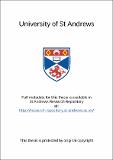Files in this item
A study of ion-molecule reactions in the gas phase using a triple quadrupole mass spectrometer
Item metadata
| dc.contributor.advisor | Tedder, John M. (John Michael) | en |
| dc.contributor.author | Mitchell, Alan Lyall | en |
| dc.coverage.spatial | 211p | en |
| dc.date.accessioned | 2021-04-08T08:56:58Z | |
| dc.date.available | 2021-04-08T08:56:58Z | |
| dc.date.issued | 1988 | |
| dc.identifier.uri | https://hdl.handle.net/10023/21813 | |
| dc.description.abstract | A triple quadrupole mass spectrometer was used to study a number of different ion-molecule reactions. The TQMS is a relatively new device, and is ideally suited to the study of gaseous ion-molecule reactions. It avoids the major complication inherent in other techniques - namely, only one primary ion is ever present in the collision chamber. Consequently, the spectra which were obtained were much easier to interpret than before. The initial experiments undertaken involved the use of two previously rarely used cationic species, CH⁺₃ and CH⁺₄ . These were reacted with n-, iso- and cyclo-alkanes, and the results showed that the two primary ionic species brought about ionisation of the collision molecules in different ways. Methane radical cation (CH⁺₄) effected ionisation by charge-transfer, whilst methyl cation (CH⁺₃) reacted via a hydride transfer, giving (M-1)+ ions. Thus ionised, we were then able to follow the breakdown of the collision molecules, producing fragmentation schemes for these species. Comparisons between the spectra for n-and iso- alkanes (using both primary ionic species), revealed that the (M-1)+ ions produced in the reactions with CH⁺₃ were in fact the same species. In other words, there is a structural rearrangement of the carbon skeleton before fragmentation. (No such rearrangement was observed for the M+ ions produced in CH⁺₄ ionisation). The reaction of methyl and trideuteromethyl cations with ethyne produced an excess of the C₃H⁺₃ ion, which was shown to have the cyclopropenyl structure, rather than the propargyl structure. The reactions of the fluoromethyl cations (CH₂F⁺, CHF⁺₂ and CF⁺₃) with the simple alkenes displayed a number of interesting reactions. In particular a "knock-on" elimination of :CF₂, and a concerted addition-elimination of fluoromethyl cation. They also gave important clues as to the actual mechanisms involved in these reactions and those of methyl cation with the simple alkenes. The remaining investigations all involved the reactions of unsaturated species, mainly the simple alkenes and conjugated dienes. The design of the TQMS also allowed the cross reactions between the various species to be very easily studied. The spectra for the ethene and propene ion-molecule reactions confirmed the reaction sequences put forward in previous studies of these systems. The butenes on the other hand produced significant differences dependent on both collision gas structure and primary ion source structure, and a change in mechanism was observed as the collision gas pressure was increased, in both the cis but-2-ene and isobutene ion-molecule reactions. (At low pressure the major reaction was collision induced dissociation, which gave way to complex formation/breakdown at higher pressures.) The fluorinated ethenes gave very interesting results when reacted with both themselves and ethene. In particular, we were able to show that reaction between the various fluorinated ethene radical cations and ethene proceeded via a loosely-bound cyclobutane transition state. Our investigations of the two C₄H₆ isomers (1,3-butadiene and but-2-yne) produced results which were at variance with the results obtained in previous studies. We showed that but-2-yne radical cation does not undergo isomerisation prior to fragmentation/reaction, whereas 1,3-butadiene radical cation does. The analogous C₅H₈ isomers (isoprene and pent-1-yne)were also investigated, and again differences were observed in the "low mass" area of the spectra, indicative of the different structures of the two primary ions. We suggest that like the 1,3-butadiene radical cation, the isoprene radical cation isomerises before reaction to the cyclopentene structure. | en |
| dc.language.iso | en | en |
| dc.publisher | University of St Andrews | en |
| dc.subject.lcc | QD561.M5 | |
| dc.subject.lcsh | Mass spectrometry | en |
| dc.title | A study of ion-molecule reactions in the gas phase using a triple quadrupole mass spectrometer | en |
| dc.type | Thesis | en |
| dc.type.qualificationlevel | Doctoral | en |
| dc.type.qualificationname | PhD Doctor of Philosopy | en |
| dc.publisher.institution | The University of St Andrews | en |
This item appears in the following Collection(s)
Items in the St Andrews Research Repository are protected by copyright, with all rights reserved, unless otherwise indicated.

